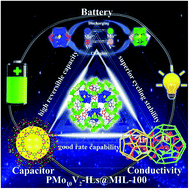Encapsulating ionic liquids into POM-based MOFs to improve their conductivity for superior lithium storage†
Abstract
Developing advanced anode materials with multi-electron reaction, adequate charge transport, and suppressed volume changes is highly desirable in lithium storage. Both polyoxometalates (POMs) and metal–organic frameworks (MOFs) are attractive candidates for anode materials because of strong multi-electron redox properties of the former and high surface areas and controllable porosities of the latter. However, the easy dissolution of POMs in an electrolyte and the intrinsically poor conductivity of MOFs result in inferior rate performance and cycling capacity. In this paper, we skillfully encapsulate ionic liquids (ILs) into polyoxometalate-based metal–organic frameworks (POMOFs) to fabricate a series of ILs-functionalized POMOF crystals (denoted as POMs-ILs@MOFs), in which POMs are immobilized in MOF cages to avoid the leaching of POMs. Also, an enhanced conductivity is obtained by the modification of ILs. One of the POMs-ILs@MOFs crystals, PMo10V2-ILs@MIL-100, when used as the anode material, shows superior cycling stability and high rate capability, which is proven to be the best amongst those of all the reported MOF, POM, and POMOF crystal materials. The outstanding performances are attributed to the hybrid behavior of a battery and a supercapacitor, which results from the synergistic effects of ILs, POMs, and MOFs. Most importantly, we not only discover a series of new anode materials but also propose a new strategy to improve the conductivity of MOFs and POMOFs, which will guide the development of other electrode materials based on MOFs and POMOFs for lithium storage.



 Please wait while we load your content...
Please wait while we load your content...